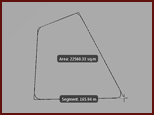You can add or modify coverage areas in a model or proposal. Use the Terrain Hole material to render part of a terrain area as a hole. This material is useful for cutting rectangular openings with a clean edge in a surface. For example, if you are modeling a rail line, the Terrain Hole can show the station entrances under the ground.
To add coverage areas
- Click




 .
. - Click on a coverage style to select that style for your coverage.
- Sketch the coverage area in the model or proposal. Note: To flatten a coverage area, see To shape terrain.
Action Result Visual Click the starting point for the coverage area and click each corner. Double-click to finish the area.
The boundary is filled by the coverage style you selected.

Coverage areas are a Surface layer in the Model Explorer, and information about them appears on the Properties Palette. The number of coverage areas, as well as information (such as area) appears in the Coverages section of the Proposals Manager.
To change the style of an existing coverage
- Select the coverage and right-click to open the context menu, then click Properties.
- In the Properties Palette, double-click on the style selected under the Manual Style field.
- Click the browse button to view available coverage styles.
- Click on a new coverage style and click OK, then click Update to apply that style to the coverage(s) you selected.
To create a hole in terrain
- Sketch the coverage area where you want the hole to appear.
For example, position the coverage over an underground area you want to be able to see from above.
- Select the coverage and right-click to open the context menu, then click Properties.
- Click the Material tab on the left side of the Select Style/Color dialog box.
- From the Material drop-down list at the top of the dialog box, select Material/Terrain.
- Click Terrain Hole and click OK, then click Update in the Properties Palette to apply the terrain hole to your coverage.
Advanced Tips
Assigning the Transparent color material to a coverage renders that coverage feature with a transparent material. If there are other coverage features (with non-transparent materials assigned to them) that cover the same area, the transparent coverage reveals those materials.